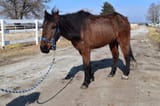Search Results
7/20/2025, 1:29:02 AM
>>715921436
I don't know what happened to the mare after she stopped racing and before I took care of her but as a horse person, it was common seeing retired race horses everywhere but especially as rescues. It's called wastage but you hope one of these horses will be the big winner and if not, they go to Canada or Mexico for meat processing if someone doesn't save them at the auction.
The other problem with keeping them is they tend to have a high metabolism then other horse breeds, they're hot-blooded (which means hyperactive and little harder to handle), and somewhat fragile so can't live in many areas. So very glad Urara is able to live much nicer whether shortly after the shitty ranch or whenever the movie and game helped her.
In the US it costs around $400-600 a month to maintain a non-working horse, not including vet care and farrier (hoof person). Its less if you live on some back-ass place like Texas or Montana. Or you can let them loose in the desert like Arizona or Nevada.
>>715921942
Ranching (beef cattle/cowboy work and even then 4x4s are starting to edge them out).
Bypassing environmental regulations in nature senstive areas like Federal Forests and Refuges. Draft horses and mules are especially used here including in europe.
Amnish still use shitloads of horses.
As for thoroughbreds, the race horse breed all Umas are, they might get use for competition in some English events, which is like that Fence Jumping stuff and moving fun. They're tend to not be good beginner or teaching horses because of how hot-blooded they are.
I have ZERO clue how retired races are handled in Japan, especially if they are losers. Same for yurop/UK.
I don't know what happened to the mare after she stopped racing and before I took care of her but as a horse person, it was common seeing retired race horses everywhere but especially as rescues. It's called wastage but you hope one of these horses will be the big winner and if not, they go to Canada or Mexico for meat processing if someone doesn't save them at the auction.
The other problem with keeping them is they tend to have a high metabolism then other horse breeds, they're hot-blooded (which means hyperactive and little harder to handle), and somewhat fragile so can't live in many areas. So very glad Urara is able to live much nicer whether shortly after the shitty ranch or whenever the movie and game helped her.
In the US it costs around $400-600 a month to maintain a non-working horse, not including vet care and farrier (hoof person). Its less if you live on some back-ass place like Texas or Montana. Or you can let them loose in the desert like Arizona or Nevada.
>>715921942
Ranching (beef cattle/cowboy work and even then 4x4s are starting to edge them out).
Bypassing environmental regulations in nature senstive areas like Federal Forests and Refuges. Draft horses and mules are especially used here including in europe.
Amnish still use shitloads of horses.
As for thoroughbreds, the race horse breed all Umas are, they might get use for competition in some English events, which is like that Fence Jumping stuff and moving fun. They're tend to not be good beginner or teaching horses because of how hot-blooded they are.
I have ZERO clue how retired races are handled in Japan, especially if they are losers. Same for yurop/UK.
Page 1
